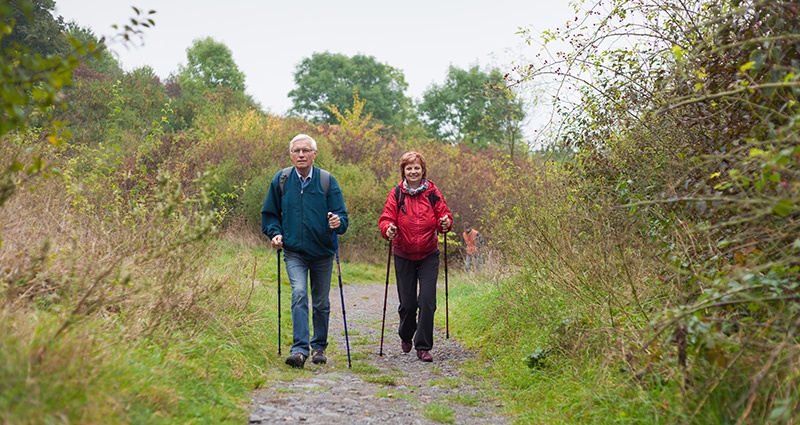It’s free. It’s easy to do. It’s relaxing.
Walking is an enjoyable exercise that you can do every day. As we age, exercising only becomes more important. Walking is an aerobic exercise that is one of the easiest exercises for staying fit physically and mentally. You can modify it any way you want—whether you take a leisurely stroll or a heart-pumping, fast-paced walk, the choice is yours.
Beneficial to Your Physical Health
Walking has been proven to treat many health ailments. Here are a few examples and how you can use walking to address these health problems.
High Blood Pressure
Walking 25-35 minutes at a moderate pace can lower blood pressure. A report by the National Heart, Lung and Blood Institute suggests that walking could reduce your risk for coronary artery disease.
Arthritis
A leisurely stroll of 5-30 minutes every day can help with arthritis. Walking strengthens bones and joints, and reduces joint stiffness. In a review of 54 studies, researchers found that walking was as effective as nonsteroidal anti-inflammatory drugs for pain relief.
Type 2 Diabetes
If you need help with blood sugar control, walking may be the answer. Walking for 15 minutes at a comfortable pace for about a half hour after eating a meal can help regulate insulin.
Insomnia
Early daylight walking for at least 15 minutes at a relaxed pace can help you sleep better. The bright light from the sun inhibits the body’s secretion of melatonin. So, when you block the melatonin in the morning, it will bounce back in the evening to help you fall asleep easier.
Meditate While Walking
Along with a lot of physical benefits, there are also benefits for your mental health! Walking increases the production of serotonin, dopamine and other brain chemicals that lift your mood.
If you enjoy meditation but don’t like to sit, you can meditate while walking. Meditation expert Andy Puddicombe says,“When you’re walking, it’s common for the legs to be moving but for the mind to be elsewhere.” The goal is to have a relaxed, focused mind to help you connect with your walking experience.
The next time you walk, try following these cues from Puddicombe for 30 seconds to a minute each.
- Notice how your body feels and walk naturally while paying attention to your posture.
- What’s going on around you? Notice colors, shapes and movements to your environment.
- Listen to the sounds. Are the leaves rustling in the trees or are birds chirping?
- Notice the smells of the environment (hopefully it’s pleasant!).
- Pay attention to physical sensations. Can you feel the wind in your hair or the warmth of the sunshine? You can also pay attention to how the ground feels on your feet.
- How is your body moving as it shifts from side to side as you walk? Concentrate the rhythm without adjusting your pace.
- If your mind starts to wonder to any stresses or worries of your day, you can bring yourself back to the rhythm of your walking pace to recenter yourself.
- Walk for as long as you are comfortable and cycle through these cues as many times as you’d like.
Before You Head Out
Ready to start making walking a daily habit? Even though walking isn’t dangerous, you can’t be too careful. Before you go, be sure to follow these walking safety tips.
- As always, consult with your doctor before taking on a new exercise.
- Start slow if you are not used to walking all the time. You can always build up as you go along.
- Stretch before and after you walk.
- Walk with a ‘walking buddy’ and always carry your cell phone.
- Invest in a good pair of walking shoes with solid support and good tread.
- Dress for the weather — in layers if it is cold and light-colored loose clothing if it is warm.
- Use sidewalks or paths. If you have to walk on the road, be sure to face oncoming traffic so you can see and be seen by drivers.
Walking and Hiking in the Hudson Valley
The Hudson Valley is a very scenic area which makes it enjoyable to walk. Depending on your preference, there are many hiking and trails to choose from. You can find an abundant list of hiking and walking trails with information on how long the trail is, difficulty, and highlights on HiketheHudsonValley.com.
As a riverside village, Kendal on Hudson has access to many walking paths for residents to take advantage of. In fact, Kendal on Hudson has direct access to the adjacent 88-acre Rockwood Hall section of the Rockefeller State Park Preserve. The park provides peaceful, countryside walking paths of all lengths.
If the weather is unruly or you would rather walk indoors, Kendal on Hudson provides a professionally staffed fitness center with state-of-the-art equipment including treadmills and an indoor pool.
Kendal on Hudson provides a lifestyle where each resident may experience his or her full potential. The Kendal environment enables residents to build a stimulating community where healthy aging, wellness, lifelong learning and social opportunities are fostered. To learn more about Kendal on Hudson, contact us or call 866-358-5802.
Share this article with your friends!












